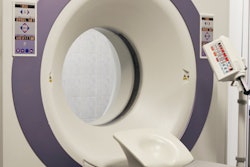
The diagnostic advantages of using CT to evaluate patients with blood in the urine, or hematuria, may be offset by a bevy of downsides, including increases in patient costs and risk of cancer from radiation exposure, according to a study published July 29 in JAMA Internal Medicine.
Currently, no prevailing strategy for the diagnostic evaluation of hematuria exists. Present guidelines vary widely in terms of recommended imaging modality, and "differing recommendations may result in considerable variation in population-level costs and patient burden from downstream sequelae," wrote first author Mihaela Georgieva, PhD, from the University of North Carolina Gillings School of Global Public Health in Chapel Hill and colleagues.
Motivated by the lack of a standard imaging protocol for hematuria, the group developed a microsimulation model using computer software that could project the outcomes of hematuria evaluation following specific guidelines. They used the simulation model to compare the costs and benefits of five of the most commonly used guidelines for initial diagnostic evaluation of hematuria:
- Dutch: cystoscopy and ultrasound for patients 50 years or older
- Canadian Urological Association (CUA): cystoscopy and ultrasound for patients 40 years or older
- Kaiser Permanente: cystoscopy and ultrasound for male smokers 50 years and older, but CT instead of ultrasound for individuals with a history of visible hematuria
- Hematuria Risk Index (HRI): cystoscopy and ultrasound for individuals at moderate risk of hematuria; cystoscopy and CT for those at high risk
- American Urological Association (AUA): cystoscopy and CT for all patients at least 35 years old
Among 100,000 adults, the model estimated that 3,514 (3.5%) would have urinary tract cancer. The model also estimated that the use of CT for all patients with hematuria was associated with substantially increased patient costs, false-positive results, procedural complications such as contrast allergy and infection, and estimated risk of future cancer induced by CT radiation.
A comparison of the guidelines recommending the most liberal use of CT (AUA) versus the most conservative (Dutch) shows a slight improvement in the detection of cancers for the AUA guidelines, including urinary tract cancer and renal cell carcinoma. However, this higher detection rate came at more than double the patient cost and procedural complication rate, triple the rate of false-positive results, and five times the risk of developing secondary cancer from radiation exposure.
| Comparison of diagnostic imaging guidelines for hematuria evaluation | |||||
| Ultrasound at 50 years or older (Dutch) | Ultrasound at 40 years or older (CUA) | Ultrasound, CT, or neither, based on risk factors (Kaiser) | Ultrasound, CT, or neither, based on risk factors (HRI) | CT at 35 years or older (AUA) | |
| Cancer detection rate | 92.9% | 95.1% | 96.3% | 96.7% | 97.7% |
| Cost per patient | $443 | $462 | $519 | $598 | $939 |
| Secondary cancer rate from CT radiation | 0 | 0 | 0.108% | 0.135% | 0.575% |
| False-positive rate | 6.5% | 6.8% | 9.1% | 13.8% | 22.2% |
| Complication rate | 8% | 8.3% | 9.6% | 9.7% | 17.6% |
"These findings support the concepts that most patients are at below-average risk [of hematuria] and may have less-than-average advantage from [CT and subsequent] treatment, and that as [treatment] intensity increases beyond an optimal level, the growth in advantages slows while harms and costs rise rapidly," the authors wrote.
The simulation study echoes reports from previous research suggesting that uniform CT scanning for hematuria -- especially microscopic hematuria -- is not cost-effective, "is ill-advised, and should be replaced with risk-based approaches and increased use of renal ultrasonography," Dr. Scott Bauer and colleagues from the University of California, San Francisco wrote in an accompanying editorial.
"We hope [the study] will encourage the widespread use of the guidelines that take a balanced approach to maximizing the net advantage to patients and facilitating high-value care," they wrote.




















